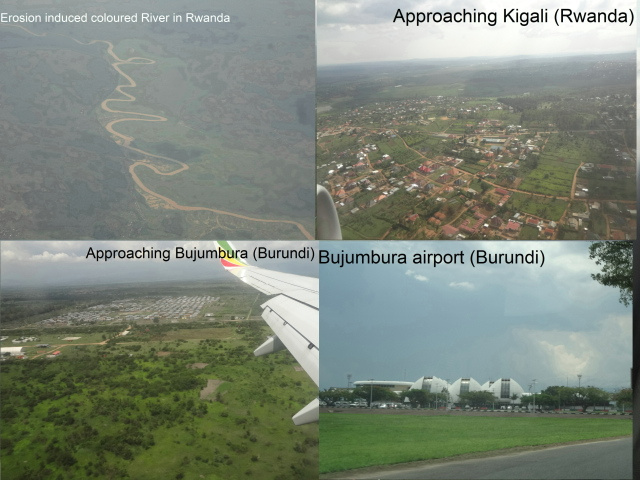9 Nov 2014
Three Days Visit trying to Understand Burundi.
It is difficult to write about Burundi without mentioning neighboring Rwanda. The two countries are like two sides of the same coin. Their origin is singular, their ethnic composition and political problems are similar. The Hutu/Tutsi divide in both countries (an Apartheid-like invention of the Belgian colonialists in the 1930s) is still the main cog in the wheel of national cohesion. The Belgians actually established identity cards that labeled people as Hutu, Tutsi, or Twa (a very small pigmy minority)! Belgians further deepened the rift by favoring Tutsis (14%) in governance, administration, army, business & education. That exacerbated the animosity of the Hutus (85%) towards the Tutsis and hence created the fertile grounds for the different bouts of civil wars & genocide that have characterized the past in Burundi & Rwanda.

For those of us living in Cameroon or Nigeria where the principal thing that distinguishes ethnic groups is language, I initially found it difficult to understand why the Tutsi minority and Hutu majority (who speak the same Kirundi language) should not easily get along. Despite some discernable differences in physical characteristics, there is no iron clad difference between a Hutu and a Tutsi to warrant the mutual suspicion and hatred that has kept them on edge for too long. I found this short video by Tharmu which confirmed the fact that I am not alone to see little difference between the two groups. https://www.youtube.com/watch?v=6TOSq9a8Hc8
By the time I came visiting there was relative calm in Burundi and there is a general perception and wish that the current peaceful environment would last for a long time. Post genocide Rwanda on the other hand has made a more rapid economic progress than Burundi.
My trip to Bujumbura, Burundi was an extension of my initial trip to Addis. Bujumbura is about 1700 kms away from Addis and we had to make a stopover in Kigali (Rwanda). Seen from the air, it is easy to understand from the pattern of human settlement that Rwanda is one of the countries with a high population density (over 400 persons per square kilometer). Excluding the African Islands in the Indian Ocean, Burundi is second to Rwanda in population density on the African continent. With less than 6% of the surface area of Cameroon, Burundi has an estimated population of 10million (roughly half of Cameroon’s).

I was received at the Bujumbura airport by my hosts Dr Timah and Dr Kwende (both medical volunteers with the UN unit in Burundi). The current UN presence in Burundi dates back to 2004 when they came in to pacify and stabilize Burundi following the bloody political clashes that engulfed the country esp. following the assassination in October 1993 of the country’s first democratically elected president.
Bujumbura sits at the northern bank of the 680 km long Lake Tanganyika. When geographers refer to this area as the Great Lakes Region, you need to see the sizes of the lakes (Victoria, Tanganyika, Malawi, Kivu, Edward, Albert) to appreciate this appellation.
We drove southwards parallel to the banks of Lake Tanganyika from Bujumbura to Nyanza-Lac near the border with Tanzania. On the way we stopped at the Livinstone- Stanely monument at Mugere. This is said to be the spot where David Livingstone (an explorer missionary) and Morton Stanely (a journalist) visited and spent two nights in 1871.) The distance between Bujumbura and Nyanza- Lac (135 kms) represents more than half of Burundi’s diameter. Along the road, one could see artisanal burnt bricks and palm oil producing industries. They grow bananas but not plantains. Common crops like cassava and fruit trees like avocado grow in Burundi.

If you want to know the value of a bicycle, you better visit Burundi. Bicycles are used here alongside motorcycles and cars as taxis. A visitor to Burundi is usually amazed at the amount of load that is transported on bicycles.
Despite its limited resources, Burundi seems to have a better sense of direction than some African countries. They have built decent schools mostly with local materials. They also construct many intra city streets with local materials using mostly manual labour. Most of Bujumbura is properly planned and the streets are relatively large and clean.
When in Bujumbura, do not fail to visit the section of the city that is perched on the hill. It is an exquisite neighborhood and a place to get a panoramic view of the rest of Bujumbura. A trip to the border post with Congo D.R (not very far from Bujumbura) is also worthwhile.
People in Burundi are generally warm towards visitors but many can only communicate in Kirundi.
Related Article: Visit to Ethiopia http://www.njeitimah-outlook.com/articles/article/2076041/180359.htm
Njei Moses Timah
|